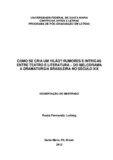| dc.creator | Ludwig, Paula Fernanda | |
| dc.date.accessioned | 2012-09-26 | |
| dc.date.available | 2012-09-26 | |
| dc.date.issued | 2012-03-01 | |
| dc.identifier.citation | LUDWIG, Paula Fernanda. HOW TO CRIATE A VILLAIN? RUMORS AND INTRIGUES BETWEEN
THEATER AND LITERATURE FROM MELODRAMA TO BRAZILIAN
DRAMATURGY IN THE NINETEENTH CENTURY. 2012. 122 f. Dissertação (Mestrado em Letras) - Universidade Federal de Santa Maria, Santa Maria, 2012. | por |
| dc.identifier.uri | http://repositorio.ufsm.br/handle/1/9865 | |
| dc.description.abstract | This work aims to understand the consolidation of the villain as a stereotypical
character, representative of questions related to conception of social, cultural and
historical values, according to a collective imagination. For tihs, it seeks to support
the comparative analysis of two works in which we can see the configuration of this
character one, linked to a theater type, very popular, the melodrama, and other
linked to Brazilian dramaturgy in the nineteenth century. This approach favors the
observation of relevant aspects about the development of theater in Brazil, at a time
when there was an accentuated movement towards the establishment of a national
culture. In this context, there was a conflict between the aim of producing works of
literary quality, according to foreign standards (mostly European) and scenic
exercise. However, in this period, there was a predominance of representations of
popular forms, like the melodrama, acclaimed by general public. Its success
stimulated influence of its features in writing of the national works, encouraged the
exploration of aspects like the utilization of villains characters and the relationship
between written text and elements of the scenic spectacle, approaching theatre and
literature with the composition of spectacular texts, based on the use of rubrics.
Therefore, in this study, we present a show that this happened in practice and
suggest its income in the characterization of the Brazilian literature. | eng |
| dc.description.sponsorship | Coordenação de Aperfeiçoamento de Pessoal de Nível Superior | |
| dc.format | application/pdf | por |
| dc.language | por | por |
| dc.publisher | Universidade Federal de Santa Maria | por |
| dc.rights | Acesso Aberto | por |
| dc.subject | Vilão | por |
| dc.subject | Melodrama | por |
| dc.subject | Teatro | por |
| dc.subject | Literatura | por |
| dc.subject | Villain | eng |
| dc.subject | Melodrama | eng |
| dc.subject | Theatre | eng |
| dc.subject | Literature | eng |
| dc.title | Como se cria um vilão? Rumores e intrigas entre
teatro e literatura do melodrama à dramaturgia
brasileira no século XIX | por |
| dc.title.alternative | How to criate a villain? Rumors and intrigues between
theater and literature from melodrama to brazilian
dramaturgy in the nineteenth century | eng |
| dc.type | Dissertação | por |
| dc.description.resumo | Este trabalho almeja compreender a consolidação do vilão como uma
personagem estereotipada, representante de questões relacionadas à concepção de
valores sociais, culturais e históricos, de acordo com um imaginário coletivo. Para
tanto, busca-se apoio na análise comparativa de duas obras em que se pode
observar a configuração dessa personagem uma delas, representante de um tipo
teatral de forte apelo popular, o melodrama, e a outra, vinculada à dramaturgia
brasileira produzida no século XIX. Tal abordagem favorece a observação de
aspectos relevantes acerca do desenvolvimento do teatro no Brasil, numa época em
que se verifica um movimento acentuado em prol do estabelecimento de uma cultura
nacional. Nesse contexto, destaca-se um conflito entre o intuito de produzir obras de
qualidade literária, de acordo com padrões estrangeiros (europeus, sobretudo) e o
exercício cênico, em que se nota a predominância de representações de formas
populares, como o melodrama, aclamado pelo grande público. Seu sucesso perante
a plateia estimulou a influência de características de sua estrutura dramática sobre a
escrita de obras nacionais, favorecendo a exploração de personagens-tipo (dentre
elas, o vilão) e a relação do texto escrito com elementos próprios do espetáculo
cênico, aproximando encenação teatral e literatura a partir da composição de peças
que consagraram o uso sistemático de rubricas. Assim sendo, neste estudo,
apresentamos uma mostra de que isso se deu na prática e sugerimos seu
rendimento na caracterização da literatura dramática brasileira. | por |
| dc.contributor.advisor1 | Santos, Pedro Brum | |
| dc.contributor.advisor1Lattes | http://buscatextual.cnpq.br/buscatextual/visualizacv.do?id=K4728603A6 | por |
| dc.contributor.referee1 | Hartmann, Luciana | |
| dc.contributor.referee1Lattes | http://buscatextual.cnpq.br/buscatextual/visualizacv.do?id=K4707953Y9 | por |
| dc.contributor.referee2 | Pereira, Lawrence Flores | |
| dc.contributor.referee2Lattes | http://buscatextual.cnpq.br/buscatextual/index.jsp | por |
| dc.creator.Lattes | http://lattes.cnpq.br/0453963988103126 | por |
| dc.publisher.country | BR | por |
| dc.publisher.department | Letras | por |
| dc.publisher.initials | UFSM | por |
| dc.publisher.program | Programa de Pós-Graduação em Letras | por |
| dc.subject.cnpq | CNPQ::LINGUISTICA, LETRAS E ARTES::LETRAS | por |


